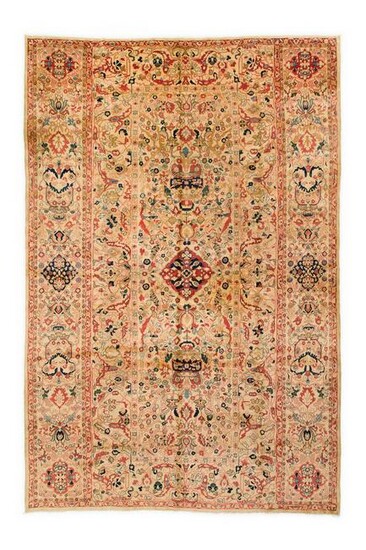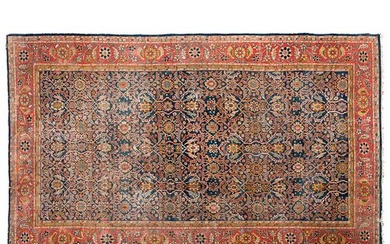Sultanabad 554 X 369 cm
Origin  central Persia Size 554 X 369 cm (Approximately 218.1 X 145.3 inch) Age 2 nd quarter of 20th century Knots 5 x 5 = 25 knots per sq cm Condition Excellent, ready to use. Description of Design and History Antique Sultanabad Rugs The city of Sultanabad (which is now known as Arak) was founded, in the early 1800„¢s, as a center for commercial rug production in Iran. During the late 19th century, the firm of Hotz and Son and Ziegler and Co. established a manufactory in Arak/ Sultanabad whose sole objective was to produce rugs to meet the western demands. They even brought over western designers to conform to the western tastes of the time. This was the first instance of a hands-on western influence in the industry (which until this point was sheltered from western insights). The large scale, all over design, and use of western color palettes are all characteristics of trends that have been influenced by Zieglers and many even attribute this style with the initial formation of the Arts and Crafts movement. The term Sultanabad has come to distinguish the oldest and highest quality Mahal rugs which were produced in the Arak region. Sultanabad rugs and carpets were made in the same area as the earliest Farahans and Sarouks, but they are very different. Ultimately, Sultanabad rugs and carpets share a common classical Persian repertoire of floral motifs, whether they utilize medallion or overall designs of vinescrolls and palmettes. However, Sultanabad rugs and carpets tend to have a larger, more supple weave (and accordingly exhibit a bolder, more large scale design). Indeed the design of Sultanabads resembles that of Heriz or Serapi somewhat in its graphic and monumental character, but even so the linework is always more curve-linear and classical. Sultanbad rugs and carpets also often have a rich, warm palette like that of Farahans and the earliest Sarouks. The rugs of Sultanabad are extremely desirable in the modern marketplace. The popularity of Sultanabad rugs go back to the mid-19th century. These carpets were designed and produced primarily for export to European consumers, as was the case with the Ziegler firm. Designers in Sultanabad tinkered with Persia„¢s traditional color palettes and reinvented ancient Persian designs to better suit Western tastes. These magnificent carpets often feature spacious floral patterns, well-defined arabesques and stark medallions woven in strong jewel tones. Although the rugs of Sultanabad were not always considered purely Persian, they have become classics in their own right. Carpets inspired by the designs of Sultanabad are still manufactured for Western consumers today. Antique pieces from the area sell for top-dollar at auction. Carpets from Sultanabad feature a diverse selection of colors that defy classification. Traditional color palettes found on carpets from Sultanabad can include subtle neutrals, vibrant reds and clear blues that create a regal Western appearance. Unique color combinations, such as tourmaline pink paired with oxidized green, are also found on rugs from Sultanabad, which highlights their tendency to reinvent the traditional. The diverse style of Sultanabad rugs gives buyers the opportunity to choose between light and airy neutrals or richly colored carpets that provide a somber, grounded feeling. In the modern home environment, antique Sultanabad rugs have the ability to unite the old with the new. All natural dyes are paramount for the carpet to have more than just decorative value. Beyond that, various dyers had varying levels of skill and invested different lengths of time in dyeing the yarns. The œquality of color€œits radiance and level of nuance within each color€œis centrally important. Certain rare colors such as Tyrian purple, saffron yellow, cochineal rose and greens add to the carpet„¢s value
Condition Report: The absence of a condition report does not imply that the lot is in perfect condition. Please carefully read our terms of sale, shipping pick up & payment information. We are happy and willing to answer questions about any of our lots as well as to send additional images. It is the responsibility of the bidder to pose any questions BEFORE bidding. Please email us for a shipping quote if needed. All sales are final.
View it on
Estimate
Time, Location
Auction House
Origin  central Persia Size 554 X 369 cm (Approximately 218.1 X 145.3 inch) Age 2 nd quarter of 20th century Knots 5 x 5 = 25 knots per sq cm Condition Excellent, ready to use. Description of Design and History Antique Sultanabad Rugs The city of Sultanabad (which is now known as Arak) was founded, in the early 1800„¢s, as a center for commercial rug production in Iran. During the late 19th century, the firm of Hotz and Son and Ziegler and Co. established a manufactory in Arak/ Sultanabad whose sole objective was to produce rugs to meet the western demands. They even brought over western designers to conform to the western tastes of the time. This was the first instance of a hands-on western influence in the industry (which until this point was sheltered from western insights). The large scale, all over design, and use of western color palettes are all characteristics of trends that have been influenced by Zieglers and many even attribute this style with the initial formation of the Arts and Crafts movement. The term Sultanabad has come to distinguish the oldest and highest quality Mahal rugs which were produced in the Arak region. Sultanabad rugs and carpets were made in the same area as the earliest Farahans and Sarouks, but they are very different. Ultimately, Sultanabad rugs and carpets share a common classical Persian repertoire of floral motifs, whether they utilize medallion or overall designs of vinescrolls and palmettes. However, Sultanabad rugs and carpets tend to have a larger, more supple weave (and accordingly exhibit a bolder, more large scale design). Indeed the design of Sultanabads resembles that of Heriz or Serapi somewhat in its graphic and monumental character, but even so the linework is always more curve-linear and classical. Sultanbad rugs and carpets also often have a rich, warm palette like that of Farahans and the earliest Sarouks. The rugs of Sultanabad are extremely desirable in the modern marketplace. The popularity of Sultanabad rugs go back to the mid-19th century. These carpets were designed and produced primarily for export to European consumers, as was the case with the Ziegler firm. Designers in Sultanabad tinkered with Persia„¢s traditional color palettes and reinvented ancient Persian designs to better suit Western tastes. These magnificent carpets often feature spacious floral patterns, well-defined arabesques and stark medallions woven in strong jewel tones. Although the rugs of Sultanabad were not always considered purely Persian, they have become classics in their own right. Carpets inspired by the designs of Sultanabad are still manufactured for Western consumers today. Antique pieces from the area sell for top-dollar at auction. Carpets from Sultanabad feature a diverse selection of colors that defy classification. Traditional color palettes found on carpets from Sultanabad can include subtle neutrals, vibrant reds and clear blues that create a regal Western appearance. Unique color combinations, such as tourmaline pink paired with oxidized green, are also found on rugs from Sultanabad, which highlights their tendency to reinvent the traditional. The diverse style of Sultanabad rugs gives buyers the opportunity to choose between light and airy neutrals or richly colored carpets that provide a somber, grounded feeling. In the modern home environment, antique Sultanabad rugs have the ability to unite the old with the new. All natural dyes are paramount for the carpet to have more than just decorative value. Beyond that, various dyers had varying levels of skill and invested different lengths of time in dyeing the yarns. The œquality of color€œits radiance and level of nuance within each color€œis centrally important. Certain rare colors such as Tyrian purple, saffron yellow, cochineal rose and greens add to the carpet„¢s value
Condition Report: The absence of a condition report does not imply that the lot is in perfect condition. Please carefully read our terms of sale, shipping pick up & payment information. We are happy and willing to answer questions about any of our lots as well as to send additional images. It is the responsibility of the bidder to pose any questions BEFORE bidding. Please email us for a shipping quote if needed. All sales are final.




